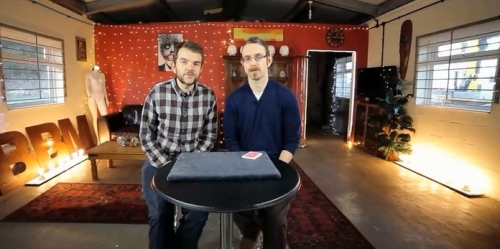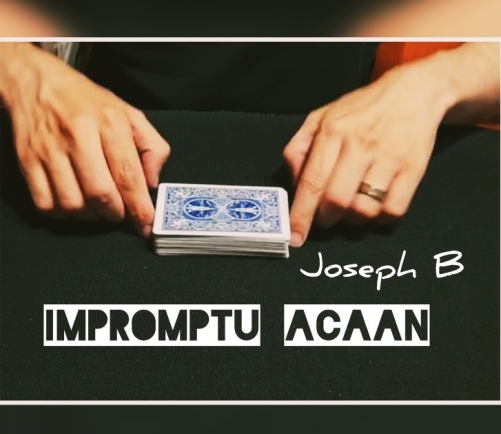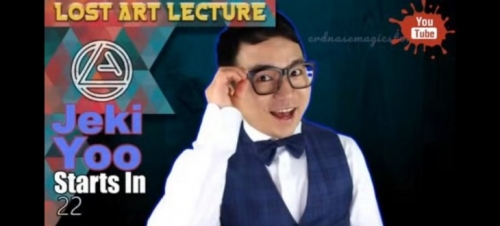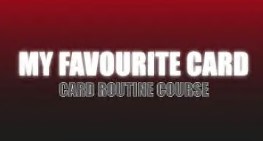Description
The enormous Larry Jennings book you’ve been waiting for.
A new Royal Road to Card Magic, Jennings style.
Over 120 Tricks / Over 120 Sleights and Techniques / 1,400 Photographs
Improve your basic card handling
New ways to do the sleights you think you know
Learn amazing tricks
No Passes, No Culls, No Palms, No Half Passes
Review by Michael Close
On page fifteen of Mr. Jennings Takes it Easy, after the Acknowledgments, the Table of Contents, and the Dedication, is an almost blank page with the three most important words of the book on it: “Lightly, Gently, Gracefully.” Below these is the admonition, “Remember these words.”
Within its almost six hundred pages, Mr. Jennings Takes it Easy offers more than 120 sleights and techniques and more than 120 tricks utilizing those sleights, described in meticulous detail by author Richard Kaufman. Although there are constant reminders throughout the book, do not forget those three guiding words: “Lightly, Gently, Gracefully.” They are the key to understanding and mastering this material.
For a big bear of a man, Larry Jennings had an extraordinarily soft touch with a deck a cards, inspired, no doubt, by his mentor Dai Vernon. In the Foreword to the book, Tony Giorgio writes, “Considering Larry’s daily labors as a plumber working with hacksaws and monkey wrenches, Dai often expressed his amazement at Larry’s delicate handling of cards; Vernon used to say that ‘it didn’t figure.’ I, too, was amazed.” Larry had moved from Detroit to Los Angeles in 1963, specifically to study with Dai Vernon. Vernon was not just an inspiration and a mentor; he was also a surrogate father figure. Jennings absorbed Vernon’s lessons and expanded upon them. He internalized and exemplified Vernon’s aesthetic approach to magic.
To understand the importance of the material in Mr. Jennings Takes it Easy, you must understand how Dai Vernon transformed close-up magic in the twentieth century. Richard Kaufman explains this thoroughly in his Introduction, but these words sum it up:
“It’s hard to imagine a card trick created in the last ninety years that hasn’t been influenced by Dai Vernon in some small way. Every time you do a Double Lift, it is Vernon’s thinking about ways to avoid simply picking the card up by the ends that guides your hands. Every time you do a Double Undercut, or Reverse Double Undercut, to control cards in the deck, it is Dai Vernon you have to thank for not having to spend five years learning the Classic Pass. His influence is so great at even the most elemental level that it is impossible to even conceive of what card magic would be like today if Dai Vernon had not been born.”
One way the Vernon aesthetic can be expressed is this: Objects are handled in an uncontrived and natural way, without arousing the slightest suspicion. Technique becomes invisible, which produces effects that look like magic.
(Important note: Mr. Jennings Takes it Easy is not just a book of techniques and tricks; it is also a book of history. Like the Introduction, each chapter of the book is preceded by an essay providing historical context of the sleight under discussion. This information is invaluable.)
Now that you have a sense of the overarching aesthetic approach espoused in the book, let me give you an overview of the material. But before I do that, let me define some terms, quoting from my essay “Sleights” in Workers 5.
“We can classify sleights into several categories (and there may be more categories than this): sleights simulating real activities (such as false shuffles and false deals); sleights in which the secret action is concealed within an overt action (the double lift, culling, the Elmsley count); and sleights containing no concealing mechanism of their own, which must be performed without the spectators’ knowledge (the pass, the top change, palming). The moves in the third category are generally the most difficult, because nothing conceals the move except the digital dexterity of the performer and his ability to control the attention of the audience. The moves in the second category are easier, because they have built-in smoke. But they also have a built-in hazard: the move only looks good as long as the covert action is handled in a natural, relaxed, and open way. The double lift is a good move only if you can handle the two cards exactly as you would handle a single card. A cull ceases to be effective if it stops being a casual spread of the cards and becomes a frantic manhunt. The sleights in the first category have an extra advantage: they are supposed to resemble real-life actions. This means we can examine the true model and practice until our sleight looks like the real thing.”
All the techniques in Mr. Jennings Takes it Easy fall into the first and second categories (most are in the second category). These are the moves traditionally classified as “easy,” and are the ones described first in beginner magic books: the double undercut, the double lift, and false counts such as the Elmsley count (these moves are discussed in chapters two, three, and four of the Jennings book). The double undercut and the double lift both rely on obtaining and secretly maintaining a break; because it is the foundation for many other moves, it is discussed in chapter one.
But here’s the catch: While it is true these moves require less digital dexterity than a pass or a top palm and are therefore “easy,” it is also easy to do these moves badly. Many magicians do not perform these moves competently, for the simple reason they have never been taught the correct methods. Happily, the proper information is now available.
After the Foreword by Tony Giorgio, a brief biography by Giorgio (which originally appeared in Genii, June 1997), Richard Kaufman’s Introduction, and a brief essay by Jennings on his early exposure to magic, Mr. Jennings Takes it Easy starts off with a chapter titled “The Breaks.” In it you’ll find a variety of ways to get a little finger break above or below a card (or cards), absolutely none of which involve riffling up the back end of the deck with the thumb. This type of fiddling around destroys the sense that “the magician didn’t do anything” and is the epitome of mediocre card handling. Of particular interest to me were two items I was familiar with but did not know were invented by Dai Vernon: the Squeeze Break (published without credit in Expert Card Technique) and Rescuing a Break (shown to me by Roger Klause without attribution). Also in this chapter: the Verdnase break (a technique for which I have devised many applications), the Jennings Pulldown (to get a break over the bottom card), the Greek break, and the Lin Searles Autobreak. The pinky count technique is not covered here, probably because it is classified as an intermediate or even a difficult move (it requires some strength and dexterity in the little finger). Don’t ignore A Brief Yet Ambitious Effect. Once you master one of the double lifts taught later, you’ll have a fine, quick effect in your repertoire.
The break-acquiring and break-holding skills are put to use in the next chapter, “Double and Triple Undercut Work.” The double undercut was devised by Dai Vernon as an alternative to the pass when controlling a card. Jennings advanced this technique by developing methods to transpose cards (for example, transposing the top and bottom cards in one double-undercut action) and to place cards in specific positions (A Placement Cut). Quite a few effects are offered using these techniques, but I would draw your attention to Always Cut the Cards, a remarkable control of the four Aces.
Once you’re comfortable using breaks, move on to Chapter Three, “Multiple Lifts and More,” a chapter with substantial meat to it. In his interview with me this month, Richard Kaufman mentions his first encounter with Larry Jennings at the Magic Castle in January of 1983. Richard could not tell if Larry was turning over a double card or a single, and thus was profoundly fooled by the effects Larry showed him. The lifts Larry used are explained in this chapter, along with the Dai Vernon Light Lift, the Vernon Pushoff Lift, Stuart Gordon’s Double Lift, and a double lift from the center of the deck. Also included are uncommon methods for getting ready for the double lift, methods for unloading cards, and many other tips and touches. There are also a bunch of tricks, including Larry’s famous Ambitious Classic Revisited.

If you can master the techniques presented in the first three chapters of Mr. Jennings Takes it Easy, you will have gotten your money’s worth. But there is much, much more. Chapter 4, “The Reluctant Packeteer,” features Larry’s handlings for the Elmsley count, the Hamman count, the Flushtration count, Ray Grismer’s count, and the Rhythm count. In this chapter you’ll find Larry’s Look – An Illusion! (which I learned from the May 1970 issue of Genii and performed all the time back in the day).
The final three chapters are titled “An Assortment of Techniques and Sleights,” “Almost Entirely Self-working,” and “Biddling and Other Ways to Avoid Palming.” Included here are several excellent false overhand shuffle methods, false cuts, the proper method for Dai Vernon’s Strip-out Addition, the Vernon Transfer Move, the D.C.D switch, and lots of other useful moves. All are accompanied by a boatload of excellent tricks.
Incidentally, throughout the book, Richard’s expert technical writing is accompanied by 1,400 excellent photographs by Julie Eng. Jason England posed for the photos.
I could go into more detail as far as individual moves and tricks are concerned, but I think it would be more valuable to you if I wrap up this review by explaining why Mr. Jennings Takes it Easy is such an important book, and why, if you want to improve your card magic, you should buy it and study it.
There are other books, such as Royal Road to Card Magic and the Card College series, which teach basic sleight of hand with cards. These books are certainly worthwhile, but none of them offer what Mr. Jennings Takes it Easy offers: a systematic reworking of every sleight, guided by an overarching aesthetic view, one of naturalness and uniformity of action. To have all this information collated in one place, organized pedagogically, so the student can progress in a logical, methodical way is a tremendous gift. Some the information is out there in other books or magazines, but it has not been explained as clearly as it is here. Unless you were diligent in seeking out these moves, or you were lucky enough to have someone teach them to you, what you learn in this book will be a revelation and will transform your card magic. Are you going to use every move or perform every trick? Of course not. But you can apply what you learn to the tricks you already perform, and they will look cleaner and more magical.
Larry Jennings left the planet too soon; because of his ill health, he never held in his hands any of the books Richard Kaufman planned with him. But I’m sure he would be pleased with Mr. Jennings Takes it Easy. It cements Larry’s legacy in magic history. If you do card magic, it is a must-buy. It has my highest recommendation.
 USD
USD



